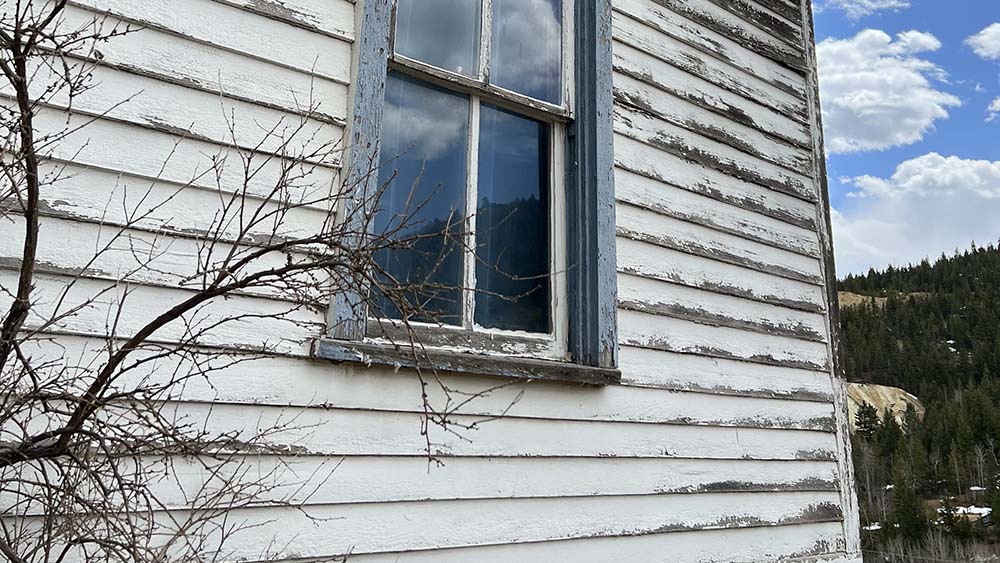Table of Contents
5 warning signs it's time to repaint (And how to make it last longer)
When my husband and I were young, we bought a home built in 1891. Saying it was a fixer-upper is an understatement. It needed just about everything refurbished or replaced. In other news, we had no money and were unknowingly starting the sometimes frustrating and always lifelong journey of home improvement. So, with a limited budget and a lack of any tangible skills, we debated how we could make the most significant impact with the smallest financial implications. We landed on an exterior paint job. Through a lot of trial and error and many mistakes made, the end result was beautiful. It also made all the difference in the world in regards to the first impression our home made.
That being said, your home’s exterior does more than make up that coveted term “curb appeal.” It also protects your interior from everything the severe Colorado weather has to offer. While your exterior paint is a great way to personalize your home with your unique style, it also protects many essential systems, including your siding. Over time, even the best paint job will show signs of wear and tear, indicating it’s time for a refresh.
Recognizing these signs early can save you money on costly repairs down the line. In this article, we’ll guide you through five clear indicators that your home’s exterior needs repainting:
- Fading Paint
- Peeling Paint
- Chalking
- Organic Growth & Mold
- Damage Or Rotting Wood & Caulking
Our aim is to provide you with expert advice to help you identify these signs and understand the best steps to take next. Whether you’re a first-time homeowner or have been managing properties for years, the guide will help protect your investments. Our goal is to provide beautiful and functional exteriors and protect you against future damage.

1. Fading Exterior Paint
With an average of 300 days of sunshine a year, Colorado residents are familiar with the issue of fading paint. Particularly on the south side of our properties which are hit with those strong rays all year round.
Fading paint is a common issue that most homeowners will have to deal with eventually. Including sun exposure, there are a variety of reasons your paint may be fading. Some of the causes of fading exterior paint include:
Sun exposure:
Our experience shows that sun exposure is the leading cause of fading exterior paint, at least in Colorado. The UV rays from the sun can be incredibly harsh. For the elevation of your home that receives direct sunlight for the majority of the day, they are particularly damaging.
UV light has the power to break down the chemical bonds in paint, causing it to lose its color and vibrancy. Fading is most noticeable in darker shades of paint, which tend to absorb more light and heat than lighter colors. Over time, this continuous exposure can result in a noticeably uneven appearance. Typically, sun-facing sides fade faster than those in the shade.
Quality of Paint:
When choosing an exterior paint, the quality of that paint plays a significant role in how well it withstands the elements, including sunlight. As an added benefit, higher-quality paints are also known to withstand impact better. Most of us have experienced a hail storm in our area in the last few years. Our inspectors find that some homes’ paint is substantially more impacted than others, and we attribute this to quality exterior paint.
Lower-quality paints may not have been formulated with the necessary UV-resistant chemicals or high-grade pigments designed to combat the sun’s damaging effects. As a result, these paints fade sooner. On the other hand, high-quality paints are specifically designed with UV inhibitors and superior pigments that help maintain their color and resist fading over time.
Color Choice:
As we briefly touched on, the color of paint you choose for your home’s exterior also affects how quickly it fades. Darker colors, such as deep reds, blues, and blacks, are more prone to fading than lighter shades. This is because dark colors absorb more light and heat, accelerating the breakdown of paint pigments and leading to fading. While these colors may offer a bold and striking appearance initially, they require more maintenance and frequent repainting to keep them looking their best.
Pro Tip: If you want the darker colors without the extra maintenance, consider using them as an accent in shaded areas such as your front porch. It’s a great location for a black entry door or dark-colored window shutters.
Weather Conditions:
Exterior paint is not only battling the sun but also all the other weather conditions experienced in your area. Extreme weather, including heavy rain, snow, and high humidity, can wreak havoc on paint. Water penetration is particularly damaging, as it can break down the adhesive bond that paint has to the surface beneath it. This not only leads to fading but can also cause the paint to peel, blister, and crack, compromising it and possibly causing expensive water damage.
Incorrect Application:
How paint is applied to your home will significantly impact its lifespan and resistance to fading. Incorrect application methods, such as failing to properly prepare the surface, not allowing adequate drying time between coats, or paining during unsuitable weather conditions, can all lead to a weaker both. This lack of adhesion makes the paint more susceptible to the effects of UV light and weather, leading to faster fading. Proper application is crucial for a durable and long-lasting finish that protects your home for years to come.

Tips to Minimize Exterior paint fading:
- Choose high-quality exterior paints specifically designed to resist UV damage and weathering.
- Consider lighter shades for your exterior, as they are less prone to noticeable fading.
- Ensure the surface is properly prepared before painting - clean, dry, and free of old, flaking paint.
- Periodic cleaning of painted surfaces can help remove dirt and grim and allow for timely inspections and touch-ups.
- Some paints come with or can be coated with protective layers that add extra UV protection and extend their lifespan.
Keep in mind that fading paint isn’t just an eyesore. It can also be a sign that your paint is starting to deteriorate. As the paint fades, it may also become less effective at protecting your home’s exterior from moisture. This can lead to moisture intrusion and lead to issues like wood rot, mold, and mildew. Addressing exterior fading early can prevent more significant and costly damage in the future.
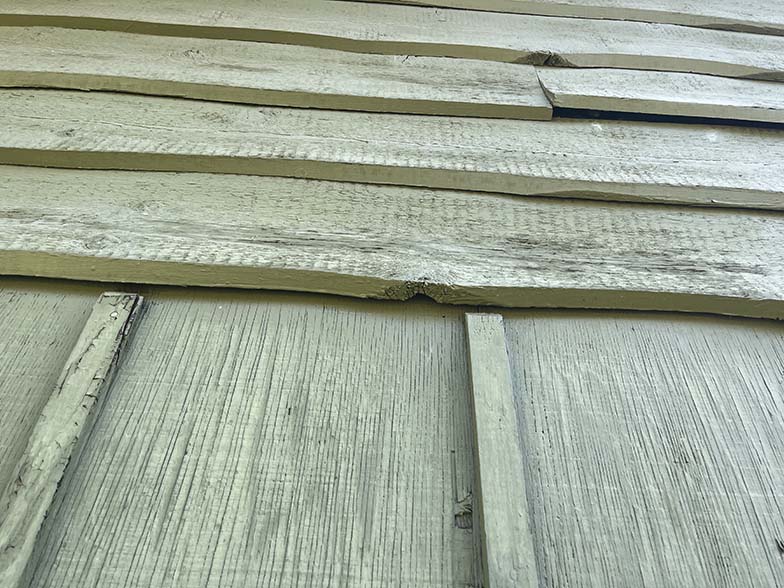
2. Peeling or Cracking Paint
By the time your exterior paint is peeling or cracking, your exterior paint is failing. This issue is not only ugly but also a definitive sign of underlying problems that need your immediate attention. This is because one of the most common culprits behind peeling or cracking paint is moisture. Sure, other issues can cause it (aging paint often cracks and peels), but often, it results from water seeping under the paint. Water can seep under the paint layer through cracks, gaps, or untreated areas, causing the paint to lose its adhesion and start to peel off. This moisture can also lead to mold and mildew growth, worsening the issue.
While moisture is a common cause of peeling paint, it can also peel due to improper installation. You risk peeling and cracking if your paint is applied over a dirty or glossy surface without proper preparation. Skipping surface prep and ensuring a clean, dry surface can lead to expensive repairs. When we are working with a customer who is replacing their home’s siding, we often recommend beginning the life of your siding with a pre-finished siding product to ensure the perfect foundation for a lifetime of exterior paint.
Over time, all paint will age and, if not maintained and refreshed, will eventually start to peel or crack. As paint ages, it loses its elasticity, making it unable to withstand normal expansion and contraction due to temperature changes. You can help prevent cracking or peeling paint by:
- Before repainting, identify any sources of moisture and issues they may be causing, and address them.
- Remove all loose, peeling, or cracked paint with a paint scraper, sandpaper, or a heat gun. (Take precautions against lead paint if your home was built before 1978)
- Use high-quality exterior paint that is suitable for the material you are painting and the climate in your area.
- Avoid painting in direct sunlight or during very hot, humid, or cold weather, as this can affect how the paint adheres.
- Regularly inspect your home for signs of wear and tear. Catch and repair minor issues early.
According to Angi, water damage restoration costs an average of $3,643 but can be as high as $15,000, depending on the source and extent of the damage.
Addressing peeling or cracking paint quickly not only improves your home’s appearance but also protects it from the damage that moisture can cause. By taking the time to both replace the aging or damaged paint and address any underlying moisture issues, you are ensuring the protection of your home and creating a durable and lasting exterior paint job.
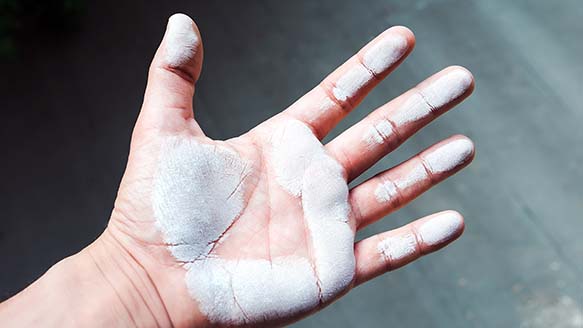
3. Chalking
If you run your hand along your exterior surface and it looks like you have chalked your hands for rock climbing, your paint is experiencing a condition called chalking. Chalking is a condition that occurs on the exterior surface of buildings where the paint has degraded to the point of forming a fine, powdery substance on the surface. This powdery residue can easily rub off on your fingers when you touch the surface. Chalking is a natural part of the paint’s aging process, but excessive chalking can indicate your paint failure needs to be addressed.
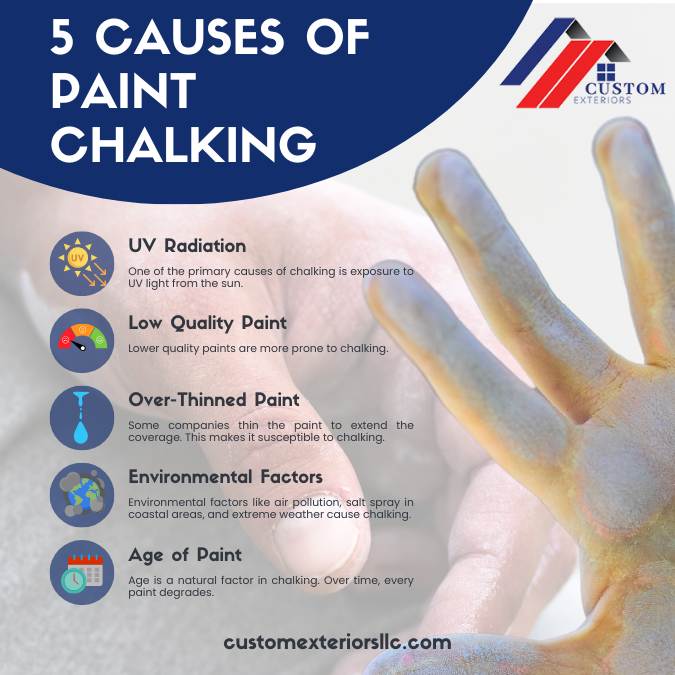
Chalking is primarily caused by these five factors:
- UV Radiation
- Quality of Paint
- Over-Thinning Paint
- Environmental Factors
- Age of Paint
How to Prevent Chalking
Because chalking is a natural stage in your paint aging, you can’t really prevent it. However, there are ways to prolong the life of your paint, putting this condition at bay for as long as possible, starting when you paint your house to begin with. Choose a high-quality paint designed to resist UV radiation and environmental degradation. These paints contain higher-quality binders and pigments that are less likely to break down into a chalky residue. It also helps to follow the manufacturer’s paint preparation and application instructions. Avoid contractors who thin your paint, and ensure you apply the recommended number of coats to create a durable finish.
Additionally, the value of regular exterior maintenance can not be overstated. Periodic cleaning of painted surfaces can help remove accumulated dirt and reduce the impact of environmental factors on the paint. This can slow the chalking process.
Recognizing the early signs of chalking and repainting before the condition becomes severe can prevent extensive surface degradation. The early signs of chalking include:
- Slight Powdering on the Surface
- Dullness in Color
- Uneven Sheen
- Difficulty Cleaning the Surface
- Fading
By catching these early signs of chalking, you can take steps to clean and maintain the surface, potentially extending the life of future paint jobs. Chalking is a natural occurrence that can’t be avoided as it is caused by environmental factors. However, choosing the right paint and following best practices in application and maintenance can significantly reduce the likelihood and severity of chalking. It will play a role in keeping your home’s exterior looking better for longer.
4. Stains or Water marks
Stains or water marks on your home’s exterior are indicators of potential problems that can compromise the integrity of your paint and cause much more significant issues. Water stains are often signals that the paint is not correctly repelling water. This can lead to water damage, mold, mildew, and other serious issues.
You will often see water marks or stains for many reasons, including:
- Water penetration due to aging paint allows moisture to penetrate the surface and cause stains and marks that are difficult to remove.
- Moisture accumulation can cause the growth of mold and mildew. This leads to dark or greenish stains that degrade paint quality and affect air quality.
- Metal components on the exterior, such as nails, fasteners, or metal fixtures, can rust and leave reddish-brown streaks on a painted surface.
- Smoke, car exhaust, and industrial pollutants can accumulate on your home's exterior, leading to stains over time.
Why it matters
Persistent stains and water marks not only have an immediate impact on your curb appeal, but they are also a good indication that your paint is failing. This failure can lead to an abundance of issues, including rot, significant repair costs, and lowered curb appeal and value.
High-quality exterior paint provides a waterproof barrier that repels water and prevents moisture penetration and the resulting stains. After addressing the underlying moisture issues, a new paint job will cover those old stains and degraded areas, significantly improving the appearance of your home.
Stains and water marks should be seen as red flags, prompting immediate action. If you can not identify and correct the moisture issues, it’s time to call in a professional exterior maintenance contractor.
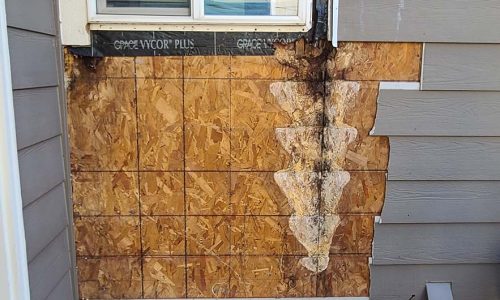
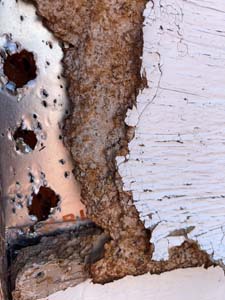
5. Wood rot or shrinking caulking
The pictures above are from a job that Custom Exteriors was called in on. As you can see, the side of the window with damaged and rotted wood has a significant amount of mold. However, notice that the other side of the window (which just had cracked caulking) also presents clear signs of water damage and mold. A lack of regular maintenance and paint/caulking caused significant additional repair costs.
Wood Rot
Wood rot occurs when water breaks the wood down, reducing its strength and structure. Unprotected wood is particularly susceptible to wood rot.
- Causes: Wood rot is primarily caused by persistent moisture exposure, often due to failing paint that no longer repels water effectively. Poorly maintained gutters, downspouts, and flashing can also contribute by allowing water to gather on wooden surfaces.
- Signs: Look for discolored patches that may be softer to the touch, flaking, or crumbling wood. Sometimes, the wood may appear darker or have a spongy texture.
- Consequences: If left untreated, wood rot can spread, compromising the structural integrity of your home. It can lead to expensive repairs, especially if load-bearing structures are affected.
Shrinking/Cracked Caulking
When siding is installed, caulking is used to seal gaps. That includes around windows, doors, and any other openings to prevent air and moisture from entering your home. Over time, caulking can dry out, shrink, and crack, leading to several problems.
- Causes: Exposure to the elements, particularly UV light, and temperature, can cause calking to lose its elasticity and contract.
- Signs: Visible gaps, cracks, or shrinkage in the caulking around windows, doors, and other seams are clear indicators. You might also notice drafts or moisture in affected areas.
- Consequences: Besides leading to water damage, deteriorating caulking can affect your home’s energy efficiency by allowing heat to escape in the winter and enter in the summer, resulting in higher energy bills.
Addressing the Issues with a new paint job
A new paint job, when done correctly, can address and prevent further wood rot and damage to caulking. Before painting, inspect your home for signs of wood rot and replace any compromised wood. Remove old, failing caulking, and reapply a high-quality, flexible caulk to seal gaps effectively.
Once the underlying issues are addressed, choose a high-quality exterior paint and apply it using exterior painting best practices.
By taking these signs seriously and investing in a comprehensive exterior paint job that includes proper surface prep and the use of high-quality materials, you can protect your home from further damage and make it beautiful at the same time!
A home that stands the test of time
Maintaining the exterior paint of your home is a crucial step. It’s important for the curb appeal of your home and also for its structural integrity. The signs of needing a new paint job – ranging from fading and peeling paint to more severe issues like wood rot and damaged caulking are clear indicators that it’s time to act. Ignoring these signs can lead to more significant, costly repairs down the line.
Your home is one of your most significant investments. Taking proactive steps to maintain its exterior will ensure its performance for years to come, improve your curb appeal, protect against structural issues, and contribute to overall energy efficiency.
Contact Us Today
We Service and Support the Following Brands




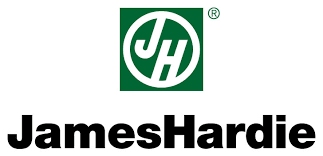

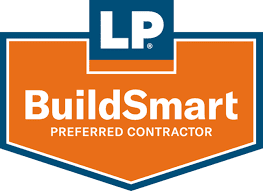
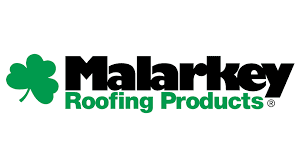


Contact
Custom Exteriors, LLC
18674 Co Rd 3, Berthoud, CO 80513
109 E. 17th St. Ste 5822, Cheyenne, WY 82001
102 S. Tejon St. Ste 1100, Colorado Springs, CO 80903
404 Broadway, Eagle CO 81631
Phone: 970-460-8714
Toll Free: 800-580-0131
Quick Links
© 2022 Custom Exteriors, LLC


